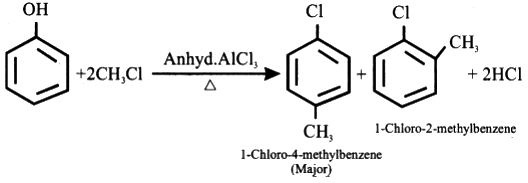
Explain Friedel-Craft alkylation of chlorobenzene. Give an equation.
Answer
432k+ views
1 likes
Hint : An alkyl group can be added to a benzene molecule by an electrophilic aromatic substitution reaction called the Friedel‐Crafts alkylation reaction. One example is the addition of a methyl group to a benzene ring. The mechanism for this reaction begins with the generation of a methyl carbocation from methyl bromide.
Complete Step By Step Answer:
Friedel-Crafts Alkylation refers to the replacement of an aromatic proton with an alkyl group. This is done through an electrophilic attack on the aromatic ring with the help of a carbocation. The Friedel-Crafts alkylation reaction is a method of generating alkyl benzenes by using alkyl halides as reactants.

A Lewis acid catalyst such as
Additional Information:
Mechanism:
The Friedel-Crafts alkylation reaction proceeds via a three-step mechanism.
Step 1
The Lewis acid catalyst (
Step 2
The carbocation proceeds to attack the aromatic ring, forming a cyclohexadienyl cation as an intermediate. The aromaticity of the arene is temporarily lost due to the breakage of the carbon-carbon double bond.
Step 3
The deprotonation of the intermediate leads to the reformation of the carbon-carbon double bond, restoring aromaticity to the compound. This proton goes on to form hydrochloric acid, regenerating the
Note :
Friedel craft alkylation will undergo that aromatic compound, which is electron-rich. As it is the electrophilic substitution reaction. But, since the carbo-cations formed by aryl and vinyl halides are extremely unstable, they cannot be used in this reaction. And also the presence of a deactivating group on the aromatic ring can lead to the deactivation of the catalyst due to the formation of complexes.
Complete Step By Step Answer:
Friedel-Crafts Alkylation refers to the replacement of an aromatic proton with an alkyl group. This is done through an electrophilic attack on the aromatic ring with the help of a carbocation. The Friedel-Crafts alkylation reaction is a method of generating alkyl benzenes by using alkyl halides as reactants.

A Lewis acid catalyst such as
Additional Information:
Mechanism:
The Friedel-Crafts alkylation reaction proceeds via a three-step mechanism.
Step 1
The Lewis acid catalyst (
Step 2
The carbocation proceeds to attack the aromatic ring, forming a cyclohexadienyl cation as an intermediate. The aromaticity of the arene is temporarily lost due to the breakage of the carbon-carbon double bond.
Step 3
The deprotonation of the intermediate leads to the reformation of the carbon-carbon double bond, restoring aromaticity to the compound. This proton goes on to form hydrochloric acid, regenerating the
Note :
Friedel craft alkylation will undergo that aromatic compound, which is electron-rich. As it is the electrophilic substitution reaction. But, since the carbo-cations formed by aryl and vinyl halides are extremely unstable, they cannot be used in this reaction. And also the presence of a deactivating group on the aromatic ring can lead to the deactivation of the catalyst due to the formation of complexes.
Recently Updated Pages
Master Class 11 Economics: Engaging Questions & Answers for Success

Master Class 11 Business Studies: Engaging Questions & Answers for Success

Master Class 11 Accountancy: Engaging Questions & Answers for Success

Master Class 11 English: Engaging Questions & Answers for Success

Master Class 11 Computer Science: Engaging Questions & Answers for Success

Master Class 11 Maths: Engaging Questions & Answers for Success

Trending doubts
State and prove Bernoullis theorem class 11 physics CBSE

1 ton equals to A 100 kg B 1000 kg C 10 kg D 10000 class 11 physics CBSE

State the laws of reflection of light

One Metric ton is equal to kg A 10000 B 1000 C 100 class 11 physics CBSE

1 Quintal is equal to a 110 kg b 10 kg c 100kg d 1000 class 11 physics CBSE

Difference Between Prokaryotic Cells and Eukaryotic Cells




